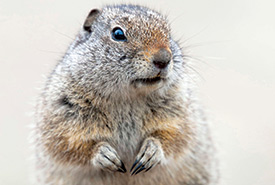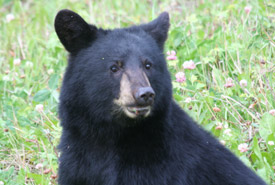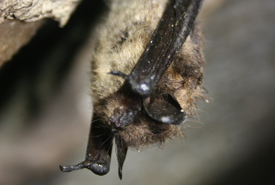Deep snooze

Richardson's ground squirrel (Photo by Alamy Stock Photo)
We often think of the saying “you snooze, you lose” as a missed opportunity, but in the case of certain animals, a good slumber is vital to their winter survival. Across the landscape, as the cold permeates and the days get shorter, the surrounding nature looks more still too. For some animals, their instinct is to enter a dormant state to conserve their bodily resources until spring. This is often referred to as hibernation, though not all animals that enter a state of dormancy in the winter are true hibernators.
Richardson’s ground squirrel
Known by many as gophers, Richardson’s ground squirrels have one of the longest hibernations of any animal in Canada. Adult males may enter hibernation as early as July and remain that way for as long as 210 days. Females and their young start their slumber a bit later,
as the ground starts to freeze in the fall. They are not seen again until the snow and ice start to recede in March or April.
Some of the places they’re found: Hopkins Conservation Site, Alberta
Black bear

Black bear (Photo by NCC)
Contrary to popular belief, bears aren’t true hibernators; instead they go into torpor. Hibernation is characterized by a significant reduction in body temperature, heart rate, breathing rate and metabolic rate. Torpor is a lighter state of dormancy that typically doesn’t last as long as hibernation. Bears can wake up from torpor to drink water or give birth, and then go back to sleep!
Some of the places they’re found: A couple of bears use NCC’s Nebo project in Saskatchewan regularly, including a female with cubs.
Gartersnake

Gartersnakes (Photo by Cory Olson)
A nice group huddle is how common gartersnakes, the most widespread of several species of gartersnakes found in Canada, like to get through the winter. While some snakes are solitary, gartersnakes congregate in a hibernaculum, a refuge used during a period of winter dormancy. For snakes, this dormancy is called brumation.
Some of the places they’re found: Most NCC-protected areas in southern BC.
Wood frog

Wood frog (Photo by Alamy Stock Photo)
Pulling a duvet over your head is what many people do to “hibernate.” So do wood frogs, sort of! This species finds a crevice in a log or a thick pile of leaves and settles in for brumation. These frogs also have anti-freeze proteins to help them survive the deep cold of winter.
Some of the places they’re found: Most wooded NCC properties from Outaouais to Gaspésie, Quebec.
Little brown bat

Little brown bat (Photo by Ann Froschauer, USFWS/Wikimedia Commons)
In late summer and fall, little brown bats migrate from their summer roosts to caves and mines, where they hibernate from October/November to March/April. Bats fly to caves and abandoned mines for hibernation, preferring the humid environment and above-freezing temperatures they provide. The conditions that bats favour for hibernacula are unfortunately similar to those that suit the fungus responsible for white-nose syndrome, a fungal disease that causes bats to wake up more than usual in hibernation, which depletes their limited energy reserves. White-nose syndrome is responsible for massive declines in little brown bat populations.
Some of the places they’re found: Little brown bats have the widest distribution of all bat species in Canada. NCC nature reserves throughout the Prairies provide important foraging and breeding habitat for this species.
This story originally appeared in the winter 2023 issue of the Nature Conservancy of Canada Magazine. To learn more about how you can receive the magazine, click here.
Explore additional content from our winter issue here >


